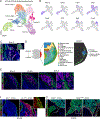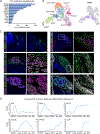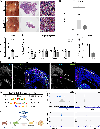Control of murine brown adipocyte development by GATA6
- PMID: 37647897
- PMCID: PMC10842351
- DOI: 10.1016/j.devcel.2023.08.003
Control of murine brown adipocyte development by GATA6
Abstract
Brown adipose tissue (BAT) is a thermogenic organ that protects animals against hypothermia and obesity. BAT derives from the multipotent paraxial mesoderm; however, the identity of embryonic brown fat progenitor cells and regulators of adipogenic commitment are unclear. Here, we performed single-cell gene expression analyses of mesenchymal cells during mouse embryogenesis with a focus on BAT development. We identified cell populations associated with the development of BAT, including Dpp4+ cells that emerge at the onset of adipogenic commitment. Immunostaining and lineage-tracing studies show that Dpp4+ cells constitute the BAT fascia and contribute minorly as adipocyte progenitors. Additionally, we identified the transcription factor GATA6 as a marker of brown adipogenic progenitor cells. Deletion of Gata6 in the brown fat lineage resulted in a striking loss of BAT. Together, these results identify progenitor and transitional cells in the brown adipose lineage and define a crucial role for GATA6 in BAT development.
Keywords: DPP4; EBF2; GATA6; UCP1; adipose tissue; brown adipocyte; brown adipocyte development; brown adipogenesis; progenitor.
Copyright © 2023 Elsevier Inc. All rights reserved.
Conflict of interest statement
Declaration of interests The authors declare no competing interests.
Figures




References
-
- Cannon B, and Nedergaard J (2004). Brown adipose tissue: function and physiological significance. Physiological reviews 84, 277–359. - PubMed
Publication types
MeSH terms
Substances
Grants and funding
LinkOut - more resources
Full Text Sources
Molecular Biology Databases
Miscellaneous

